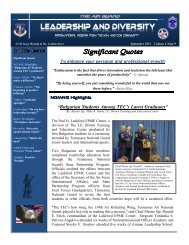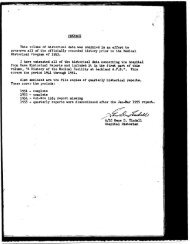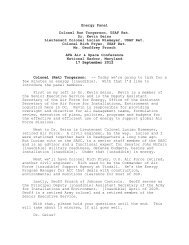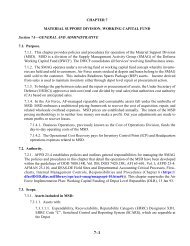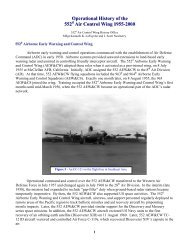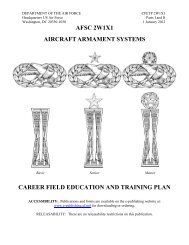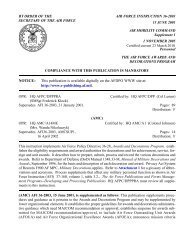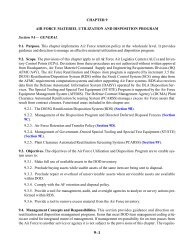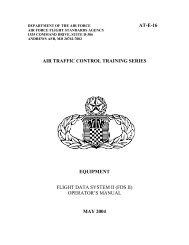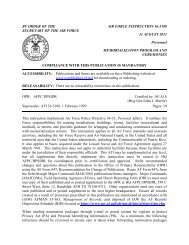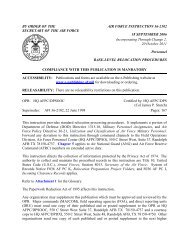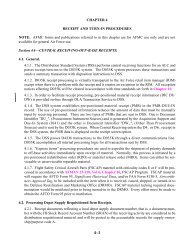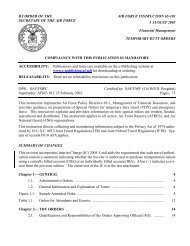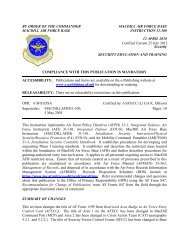MAGAZINE OF THE UNITED STATES AIR FORCE - Air Force Link
MAGAZINE OF THE UNITED STATES AIR FORCE - Air Force Link
MAGAZINE OF THE UNITED STATES AIR FORCE - Air Force Link
Create successful ePaper yourself
Turn your PDF publications into a flip-book with our unique Google optimized e-Paper software.
HERITAGE<br />
story By randy roughton J Photos By tECh. sgt. BEnnIE J. daVIs III<br />
Forever the<br />
candy bomber<br />
a sPlIt-sECond dECIsIon to sharE Candy<br />
ratIons wIth BloCkadEd ChIldrEn<br />
EstaBlIshEd an aIr forCE PIlot’s<br />
lastIng lEgaCy of hoPE<br />
(this page)<br />
Then-1st Lt. Gail<br />
Halvorsen, an <strong>Air</strong><br />
<strong>Force</strong> pilot serving<br />
in the Berlin <strong>Air</strong>lift,<br />
offered hope to<br />
children of West<br />
Berlin through<br />
his actions as<br />
the Berlin Candy<br />
Bomber.<br />
(opposite)<br />
Retired Col.<br />
Gail Halvorsen<br />
is greeted by a<br />
young girl at the<br />
60th Anniversary<br />
of “Operation<br />
Little Vittles.”<br />
With<br />
Hitler’s<br />
crumbled<br />
Third<br />
Reich<br />
in their memories and Stalin’s<br />
chokehold on their future,<br />
Germany’s children were starving.<br />
But as an American pilot<br />
learned in a conversation with<br />
German youth at Templehof<br />
<strong>Air</strong> Field in July 1948, they<br />
were hungry for more than<br />
food. What they wanted most<br />
was freedom, but the pilot’s<br />
split-second decision to share<br />
his chewing gum led to hope in<br />
the form of candy descending<br />
from tiny parachutes in the West<br />
Berlin sky.<br />
“I got five steps away from<br />
them, and then it hit me,” said<br />
44<br />
www.aIrManonline.af.mil<br />
retired Col. Gail Halvorsen,<br />
commonly known as the Berlin<br />
Candy Bomber. “I’d been deadstopped<br />
for an hour, and not one<br />
kid had put out their hand. Not<br />
one. The contrast was so stark<br />
because during World War II<br />
and all the way back to George<br />
Washington, if you were in an<br />
American uniform walking down<br />
the street, kids would chase you<br />
and ask for chocolate and gum.<br />
“The reason they didn’t was<br />
they were so grateful to our fliers<br />
to be free. They wouldn’t be a<br />
beggar for more than freedom.<br />
That was the trigger. Scrooge<br />
would’ve done the same thing. I<br />
reached into my pocket, but all I<br />
had were two sticks of gum. Right<br />
then, the smallest decision I made<br />
changed the rest of my life.”<br />
Then-1st Lt. Halvorsen, who<br />
retired from the <strong>Air</strong> <strong>Force</strong> as a<br />
colonel in 1974, was one of the<br />
American pilots flying round-theclock<br />
missions from Rhein-Main<br />
<strong>Air</strong> Base to Templehof, with<br />
126 missions from July 1948<br />
to February 1949. One day the<br />
American pilot, who the German<br />
children would later call “Onkel<br />
Wackelflugel” or Uncle Wiggly<br />
Wings, made the decision that<br />
would not only change the lives<br />
of numerous German children,<br />
but also help the West win the<br />
ideological war in the battle for<br />
Germany’s future.<br />
More than three years after<br />
World War II ended, on June<br />
24, 1948, the Soviet Union<br />
blocked the Allies’ railway and<br />
road access to Berlin to force<br />
acceptance for its plans for<br />
Germany’s future. The Berlin<br />
<strong>Air</strong>lift began two days later, with<br />
U.S. <strong>Air</strong> <strong>Force</strong> C-47 Skytrains<br />
and C-54 Skymasters delivering<br />
milk, flour and medicine to West<br />
Berlin. Throughout the duration<br />
of the blockade, U.S. and British<br />
aircraft delivered more than 2.3<br />
millions tons of supplies.<br />
Colonel Halvorsen was at<br />
Templehof filming aircraft landings<br />
with his Revere movie camera<br />
when he encountered about<br />
30 German children between<br />
the ages of 8 and 14, he said in<br />
his autobiography, “The Berlin<br />
Candy Bomber.”<br />
He greeted them with practically<br />
all the German he knew, but<br />
one of the group spoke English,<br />
and he was soon answering<br />
questions about how many<br />
sacks of flour and loaves of<br />
bread the airplanes carried and<br />
what other types of cargo were<br />
being airlifted.<br />
He talked with the children for<br />
an hour before he realized not<br />
one had asked him for anything.<br />
Instead, they gave him something<br />
he didn’t expect: the best lesson<br />
on freedom he’d ever heard.<br />
“Hitler’s past and Stalin’s<br />
future was their nightmare.<br />
American-style freedom was<br />
their dream,” Colonel Halvorsen<br />
said. “They knew what freedom<br />
was about. They said someday<br />
we’ll have enough to eat, but if<br />
we lose our freedom, we’ll never<br />
get it back.<br />
“These were kids, and they<br />
were teaching me about freedom.<br />
That’s what just blew me away.”



